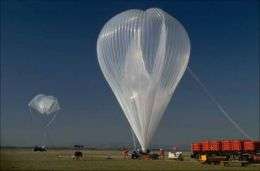With stratospheric balloons researchers derive the 'age' of the air from trace-gas measurements. Their results indicate that air masses are moving more slowly than predicted by climate models. Credit: Andreas Engel
Most atmospheric models predict that the rate of transport of air from the troposphere to the above lying stratosphere should be increasing due to climate change. Surprisingly, Dr. Andreas Engel together with an international group of researchers has now found that this does not seem to be happening. On the contrary, it seems that the air air masses are moving more slowly than predicted. This could also imply that recovery of the ozone layer may be somewhat slower than predicted by state-of-the-art atmospheric climate models.
The researchers have published their results in Nature Geoscience (10.1038/NGEO388). They investigate the time it takes to transport the atmospheric trace gases sulfurhexafluoride (SF6) and carbon dioxide (CO2) from the troposphere (the atmospheric layer between the ground and about 10 km) to the stratosphere (the atmospheric layer between about 10 and 50 km altitude). They derive this "age" of the air from trace-gas measurements performed with large research balloons carrying measurement instrumentation up to altitudes of 35 km . As these measurements are quite complex and expensive, they can only be performed sporadically.
In cooperation with German, American and Japanese colleagues, the group gathered all measurements of these trace gases available world-wide. For this purpose, archived air samples which were collected more than 30 years ago in the stratosphere above North American, have been analysed in Frankfurt. Andreas Engel explains that „Sulfurhexafluoride is amongst the most stable gases in the atmosphere, meaning that using today's analytical techniques, it is possible to analyse even extremely small amounts present in the 30 year-old air samples."
While state-of-the-art climate models predict an increase in stratospheric transport and thus younger ages, the measurements indicate that the age seems to have increased slightly, meaning that the transport rates have not increased.
The Frankfurt research group wants to continue the long-term measurement series in order to provide further measurements which can help to evaluate the model predictions and document the long-term evolution of the atmosphere. Due to the results presented now, the predictions of atmospheric models must be re-evaluated. Andreas Engel emphasises that „our results do not contradict the principal global change predicted by the models, yet the exact mechanisms of how this influences transport of air in the upper atmosphere do not seem to be fully understood. More research is needed here."
Source: Goethe University Frankfurt
























